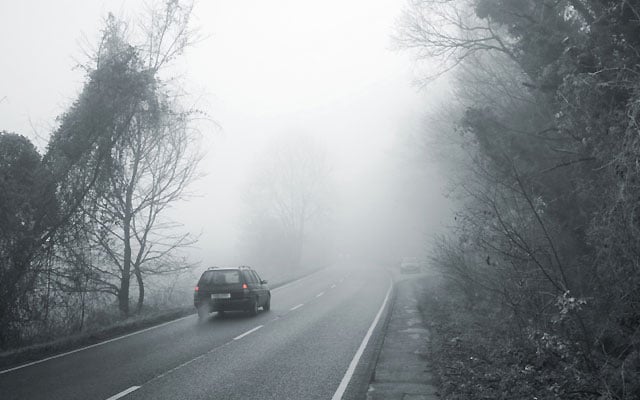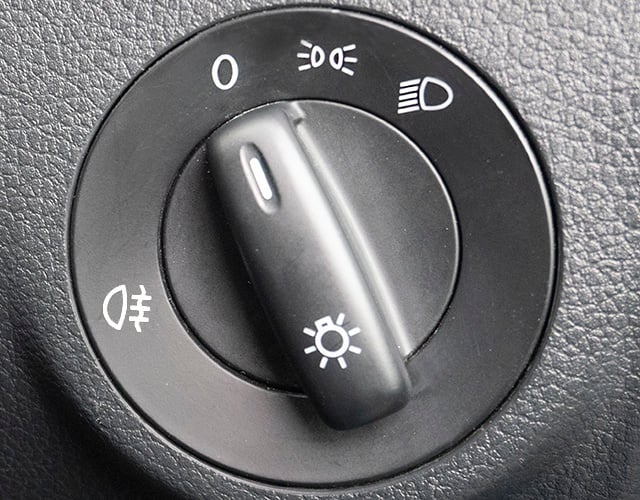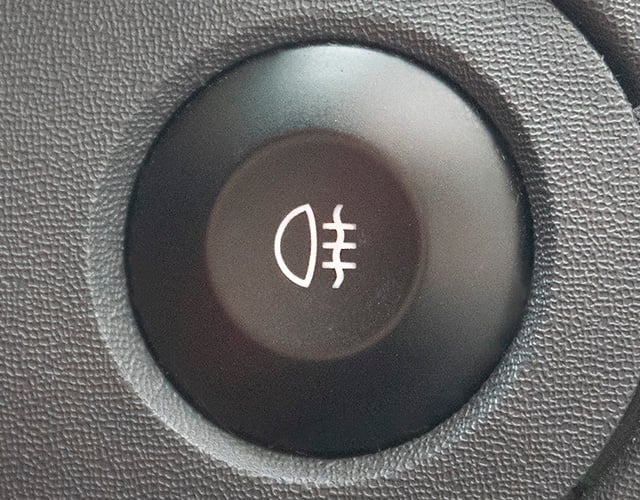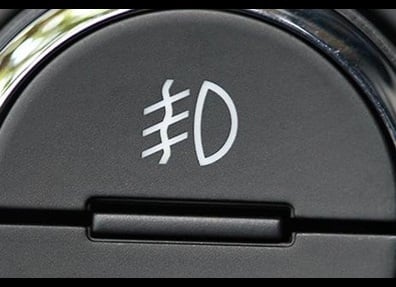Driving in fog can present a number of challenges for motorists. Thick fog can majorly reduce visibility, making it hard to spot upcoming hazards or gauge the distance between your vehicle and others.
Sometimes, you might only be able to see a few metres ahead, which makes it difficult to judge your speed or tell whether other vehicles are actually moving at all.
On this page, you can find out how to drive in fog, including our expert tips on how to stay safe and when to use your fog lights.
In this article |
How to drive in fog
The Highway Code has guidelines for driving in fog. They explain what you should do and shouldn’t do when it’s foggy.
Top tips for driving in fog:
- Use dipped headlights, wipers and demisters
- Use fog lights when you need to, but remember to switch them off once visibility improves
- Beware of other drivers not using headlights
- Only drive as fast as conditions allow
- Slow down so you can stop in the distance you can see clearly
- Allow 3 seconds instead of 2 between you and the car in front
- Check your mirrors before you slow down
- Open your window to listen for traffic at junctions if you can’t see
What you shouldn’t do when driving in fog:
- Don't rely on automatic lights – they might not come on in fog
- Don't rely on daytime running lights alone – they only light the front
- Don’t tail another car’s rear lights - it can give a false sense of security and it's dangerous
- Don't speed up to get away from a vehicle that’s too close behind you
Remember that when it’s foggy, it can be harder to tell if other vehicles are moving. Many accidents happen because drivers don’t realise that the car in front of them has stopped. That’s why it’s safer to slow down and leave a bigger stopping distance.
If it’s foggy or misty, the roads might also be wet, which means it could take longer to stop.
Find out how bad weather can affect stopping distances.

What should you check before driving in foggy weather?
If you can’t avoid driving in fog, there are a couple of things you should do before you start your journey. You’ll want to:
- Ensure your windows are clean and clear. See how to demist a windscreen on a cold day
- Ensure your lights (including fog lights) are clean, clear, and working properly so that other drivers can see them as easily as possible
- Allow more time for your journey, it’s a good idea to inform anyone expecting you that you might arrive a little later than planned
- Check that you have enough fuel (or charge if you're driving an electric vehicle). Stopping or breaking down in fog can be especially dangerous as other motorists might not realise that you're stationary.
Check that you have enough fuel (or charge if you’re driving an electric vehicle) Stopping or breaking down in fog can be especially dangerous as other motorists might not realise that you’re stationary.
What are fog lights?
Fog lights are extra front and/or rear lights on some vehicles that are designed to make it easier to see and be seen in foggy conditions.
- Front fog lights are usually white or yellow lights which sit below your headlights and can cut through fog without causing glare
- The rear fog light is a red light, similar in brightness to a brake light, on the back of your car which helps other drivers see you
What’s the difference between fog lights and headlights?
When fog reduces visibility, the moisture in the fog reflects the light from normal car headlights back, making glare worse.
The difference between fog lights and normal headlights is how they cut through the fog to reduce glare:
- Front fog lights are designed to shine downwards to illuminate the road below any hovering fog
- The top of the beam is cut off sharply so that the lights won’t reflect back off the fog
- They’re mounted lower down on the car so they can shine underneath the fog
Normal headlights aren't angled downwards in the same way and are mounted higher up on the front of the car.
Does my car have fog lights?
It’s the law for cars to have a rear fog light. Many have front fog lights too, but some modern cars use daytime running lights instead of front fog lights.
You can check your dashboard, steering wheel stalk or vehicle hand book to see if your car has front fog lights. We give an example of how the fog light symbol looks below.
When to use fog lights
Fog lights can help you to see and help other drivers see you if the weather is very misty or foggy.
- The Highway Code says you must use headlights when you can’t see for more than 100m in front of you
- You can also use front or rear fog lights but this is optional
- You must turn fog lights off when visibility improves so you don’t dazzle other drivers
If you’re not sure, it’s best to use your common sense. You don't have to use fog lights, but your insurer might take issue if you're in an accident in poor visibility and they weren't on.
When to use rear fog lights
You'll want to turn on your rear fog lights if visibility is severely reduced, this usually means that you can't see for more than 100 metres ahead. Turning on your rear fog lights will help motorists behind you to spot you, allowing them to stop in time and avoid rear end collisions.
Why is it dangerous to leave rear fog lights on?
Cars typically have only a single rear fog light, usually placed on the driver’s side or the middle of the vehicle to avoid other drivers mistaking it for a brake light. However, some cars do have two rear fog lights, which can be mistaken for brake lights – it’s dangerous to leave these on when you don’t need them as you could dazzle other drivers or make them think you’re slowing down when you aren’t.
What if you have automatic lights?
Almost 1 in 10 drivers* say they rely on their car’s automatic lights all the time. But automatic lights won’t come on if it’s foggy but bright, as they rely on light-level sensors.
Check whether you need to switch yours on manually. And watch out for almost-invisible cars whose drivers haven’t got theirs on.
Read more about automatic lights.
How do you turn fog lights on?
There's often a button or switch on your dashboard which will have the front and/or rear fog light symbol on.

Some cars control the fog lights through the steering wheel stick. Look for the fog light symbols and twist the stick to the right position to turn them on.
Fog light symbol
The rear fog light symbol is the reverse of a front fog light symbol. The straight light lines appear before the lamp image, pointing right. The front fog light symbol shows a lamp with slanting lines of light in front of it, pointing left. The lines of light are intersected by a wavy line which represents the fog.
What is the symbol for fog lights?
An example of the rear fog light symbol:

What is the symbol for front fog lights?
An example of a front fog light symbol:

Is it illegal to drive with fog lights on in the UK?
Fog lights can be helpful when conditions are very misty or foggy. But you could be penalised if you use them at the wrong time. The Highway Code states:
“You MUST NOT use front or rear fog lights unless visibility is seriously reduced (see Rule 226) as they dazzle other road users and can obscure your brake lights. You MUST switch them off when visibility improves.”
Never use fog lights when visibility is clear. If you do, you could be given a Fixed Penalty Notice with a £50 fine.
Can you use fog lights instead of headlights?
No, you should never use your fog lights in place of your headlights. If one of the bulbs in your headlamps is blown, make sure you get it replaced as soon as possible.
Perform regular car maintenance checks before you start your journey. That way, you’ll spot any problems with your lights before you get caught in the dark.
